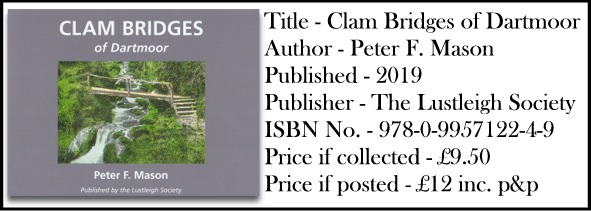
“Simple bridges made of timber, known as clam bridges, were once a common sight around Dartmoor. traditionally built from tree trunks laid across a stream or river with a hand rail on one side these bridges utilised the most common material in the river valleys that surround the moor. Bringing together for the first time evidence from photographs, maps, and documents, this book explores the significance of clam bridges and their place in Dartmoor’s cultural history.” – The Author, Clam Bridges of Dartmoor.
Many Dartmoor landscape paintings, illustrations photographs and even postcards depict an iconic clam bridge. They add an evocative air of rustic charm from halcyon days long gone by, conjuring images of moor folk going about their daily lives. As the author notes this is the first publication that examines in-depth the ‘Clam Bridges of Dartmoor’ and their history. For centuries there has been some debate as to what exactly how a clam bridge is defined. Some say they were constructed with stone slabs whilst other aver that they are made of timber. This questions is succinctly answered by the author from the inset – “clam bridges are wooden footbridges…”, p. 11. The book then goes on to examine the history of clams in such locations along the rivers Lyd, Teign, Yealm, Dart, Swincombe, Tavy, Plym, Bovey, and East Okement. Every page is lavishly illustrated with either old photographs, modern photographs, various works of art, vintage postcards and assorted maps. Most helpful are the Ordnance Survey six figure grid references for the majority of the subjects. The saga of what now is the ‘infamous’ Lustleigh Clam’ is also narrated along with the ensuing issues with the Dartmoor National Park Authority. When reading through the notes section of the book one cannot help but being impressed by the huge number of people and resources that peter Mason has consulted in the research of his book.

Old maps are not the only source in discovering the location or one-time location of Dartmoor clam bridges. Another excellent means is by examining the old Tithe Apportionments and the field names which appear on them containing the word ‘clam’. Again the author explores this subject whilst pointing out that in not every case does the word ‘clam’ allude to a wooden bridge.
This publication provides and enjoyable and interesting account of the subject and as rightly stated is the first of its kind to cover the topic. Personally this is one book that I thoroughly recommend placing on your bookshelves. With Christmas fast approaching it will also make the perfect present for the Dartmoor lover, historian or loved one. There seems to be a trend these days of ‘Bagging’ or visiting as many things on the moor such as hills, tors. trig points etc. as possible. The thought has crossed my mind that ‘Clam Bagging’ would be an interesting project, it would certainly take one to some of Dartmoor’s scenic spots and this book would make a good guide. My only criticism is that it would have been useful to have included a full page index to go along with the notes section.

The ‘Clam Bridges of Dartmoor’ was a Lustleigh Parishscape project which was funded by ‘Moor than Meets the Eye‘ which in turn is funded by the Heritage Lottery Fund. The book can be obtained either by emailing the author at dartmoorclams.gmail.com, collecting a copy from the Lustleigh post-office. or by contacting The Dartmoor News.
 Legendary Dartmoor The many aspects past and present of Dartmoor
Legendary Dartmoor The many aspects past and present of Dartmoor

Great post.